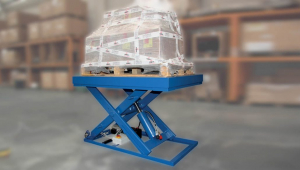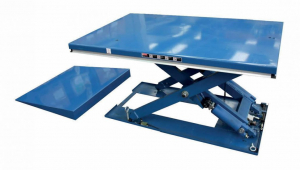Scissor lift tables: industry types and applications

The industrial scissor lifting tables, also known as “scissor table”, “lift table” or “scissor hydraulic table”, are a stable equipment which allows you to lower and lift loads through a hydraulic mechanism. It is usually used on construction sites and logistics warehouses to lower and lift loads, goods, tools and people while complying with all EU safety regulations.
How a scissor lift table works

Typically, the lifting table is a monobloc structure consisting of an upper floor, a lower floor and a scissor lifting system, driven by one or more cylinders moved by a hydraulic control unit. Each cylinder has two safety valves: one allows the controlled lowering of the table in case of damage to the pipe; the other, on the other hand, guarantees open positioning, avoiding oil leakage.
The upper floor of Armo lift table consists of a smooth or diamond sheet metal cover, according to the need for use, and moves vertically parallel to the floor. The lifting system (scissors) is connected to one end of both the upper and lower frame; the other end of the lifting system slides in special horizontal guides, thanks to wheels, allowing the lifting table to run its stroke.
The lift table is usually moved by a hydraulic pump motor. The activation of the engine through a special electrical panel allows oil to be transferred into the cylinders, thus ensuring the movement of the lifting table.
How to choose the right lift scissor table
Industrial lift tables have different characteristics, depending on the mean of use. The combination of these features allows users to meet numerous logistical needs, applying tailor-made solutions. Below, here is a list of the main properties to consider when choosing an industrial scissor lift table:
- length and width of the upper frame;
- lifting capacity (expressed in kg);
- stroke or maximum height achievable from the floor level;
- load distribution.
These are the main characteristics to be evaluated when choosing a lifting table, to let it perfectly perform its task. Particular attention should be paid to the distribution of the load. A load, in fact, can be totally distributed on the upper frame, partially distributed or totally concentrated or partially concentrated. For example, a lifting table with a partially distributed load with a capacity of 7,000 kg is equivalent to a table that lifts a capacity of 5,000 kg partially concentrated.

How to choose the right scissor lift table
According to the needs of your company, therefore, you can choose the most appropriate and effective lifting table. The differentiation of these properties involves an evident versatility of the machinery, that therefore lends itself to being used in various areas.
Areas of application of lift tables
Lifting tables can be customized according to customer needs. This makes them adaptable in any work and logistics context. Below we examine the main areas of application of scissor lifts.
Worktop and palletizing
One of the simplest uses of a lifting table is as a work table. The table is lowered and raised to a certain height to allow operators to carry out their activities in the correct position and in the most comfortable way. This also allows you to stack the goods on the pallet more effectively and safely.
For this purpose, Armo offers PXS lifting tables, useful as worktops and for lifting material with a maximum load between 500 and 2,000 kg. More than 20 models are available as standard, allowing you to use the most suited upper frame to the scope of your company, with dimensions from 1,000×800 mm to 1,500×1,000 mm, with a net stroke up to 1,000 mm.
With the special extra-flat lift table, on the other hand, Armo guarantees the ability of lifting pallets without digging any pit. The upper frame can be made of smooth sheet metal or non-slip diamond plate, with dimensions ranging from 1,400×900 mm to 1,600×1000 mm. Based on the model, the maximum load capacity can be 1,000 or 2,000 kg, while the useful stroke is about 800 mm.
Production line and automatic system subservicing
A lifting table can also be used within a production line, to bring workers to the right height, allowing them to perform their duties in the best possible way; or, again, to transpose, lower or lift components that must be processed with precision and with specific techniques, or that must be brought to the ground at the end of the production line, with subsequent automatic palletizing operations. In these cases, therefore, a lift table is designed to fit perfectly into the production cycle, in combination with other machinery.
Freight elevator and table connecting two floors
The need to transport materials, tools and goods to the upper floors of a factory, warehouse or building is met very well with a lifting table.
The lifting and lowering technology, in fact, is well suited to the function of a freight elevator and, also, allows you to leave most of the available space suitable for the material, thanks to the handling system present under the table. Finally, its hydraulic power pack guarantees a wide range of rated capacities: together with the flexibility of installation, it meets every need in industrial and civil applications.
Armo’s elevator scissor lift table models allow you to overcome differences in height up to 6 meters, with capacities from 500 to 7,000 kg. They can be used as elevators or to transport cars, they are also suitable for building contexts and can be adopted to overcome architectural barriers.
Logistics for loading and unloading goods
In a logistical context, lifting tables allow you to lift and transport material (and possibly also operators) at the height of the vehicle they have to load or unload. Armo’s solution works in this way: casted in the floor (when possible), the operator and the material enter the upper frame; subsequently, thanks to its scissors, the table raises to the truck loading level where, usually, a lip is used to connect the two surfaces.
Thanks to the scissor lift table for truck loading/unloading, therefore, operations are faster and safer. Armo offers solutions with upper floor in diamond sheet, with dimensions up to 4,500×2,400 mm, capacity up to 6,000 kg concentrated and useful stroke up to 1,700 mm. The customer can choose sizes and options of the lift machine to go for a customized table, perfect for their needs.
Car lift tables
In addition to industrial applications, lifting tables can also be used in civil and private environments. This is the case of garages or parking lots in lower floors, protected from the weather: a lifting table allows you to load a car on the street level and, then, lower it automatically and in total safety.
Armo’s Car lift tables allow you to avoid expensive excavations and save space. They can be equipped with an additional roof, with connection to the photovoltaic system or the installation of charging stations for electric cars. To make the structure even safer, it is also possible to install customizable gates and protections.
Accessories for lifting platforms
In order to enhance the safety and performance of scissor lift tables, it is possible to install different types of accessories. Below some samples about options available by Armo:
- manual or hydraulic loading lip, hinged on the upper floor to connect the table with the truck body;
- strengthening of the upper floor of the table which, once closed flush with the floor, allows the transit of vehicles with a maximum weight of 15 tons;
- controls fixed on the upper frame, allowing operators to use the table even above it;
- handrails and gates with electric locks, drop-down bolts or self-closing bulkheads;
- hot dip galvanizing and metallization for outdoor lifting tables to protect the structure from the weather;
- 120 mm thickness under the table to easily move it by pallet truck or forklift;
- other options on request, such as hydraulic pins, additional shelves, tilting table and automations.
Why rely on Armo lifting tables
Experience, quality and safety: these are the characteristics guaranteed by Armo. With its lift tables, Armo is able to provide customized solutions for the logistics companies. State-of-the-art equipment and machinery allow optimal and reliable material handling: each lifting table complies with the European standards EN1570-1, EN1570-2 or EN1570-3, ensuring the safety of operators and the application of the CE mark.
In addition, all the devices, completely built and assembled in the Italian production plants, are guaranteed for 24 months after delivery, accompanied by the relative declarations of conformity according to European standards. Armo ensures that every processing of raw materials, from design to testing, is managed in a single plant to ensure rapid and timely order fulfilment.
